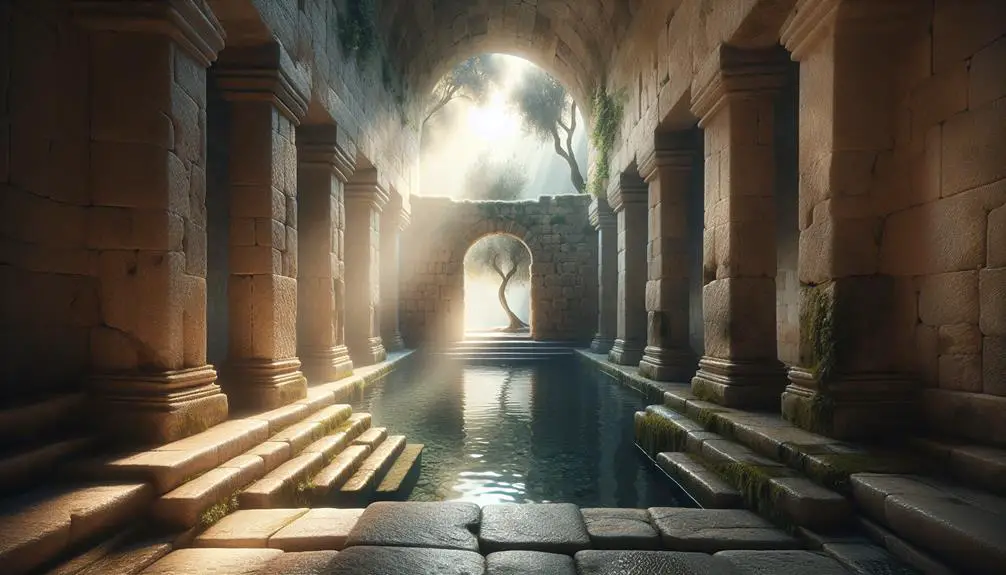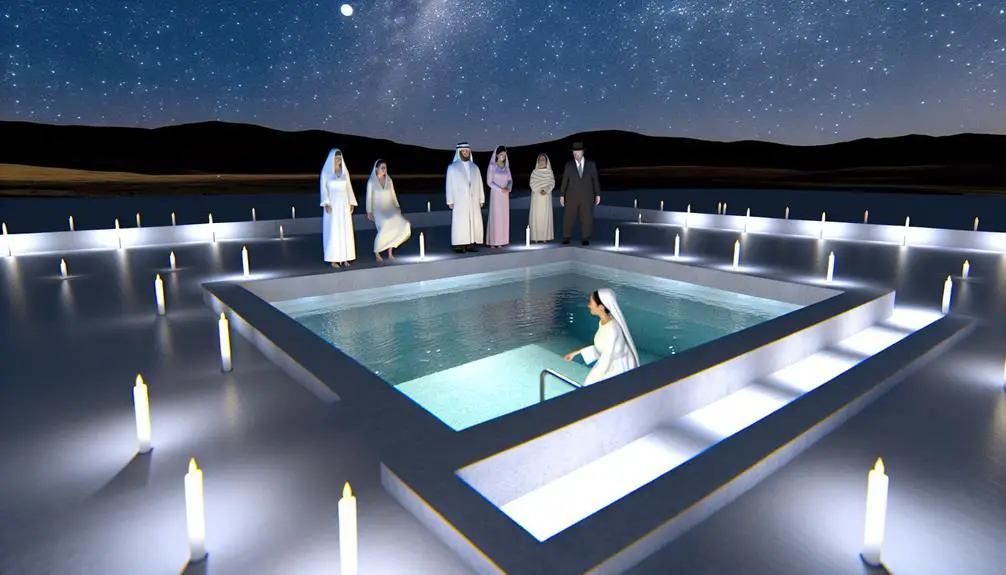Immerse yourself in the ancient ritual of Mikvah, unlocking secrets of purity and spirituality hidden within the Bible's pages—discover more.

Mikvah in the Bible
You might think the concept of the mikvah is only a minor detail in the broader context of biblical teachings, but its significance runs deep, intertwining with both the physical and spiritual realms of purity.
As you explore the origins and evolution of this ritual bath, from its detailed prescriptions in Leviticus to its symbolic presence in the New Testament, you'll uncover layers of meaning that have influenced modern interpretations and practices.
This journey through ancient texts and traditions will challenge your understanding of purity and spirituality, inviting you to consider the profound impact of the mikvah on faith and identity.
Key Takeaways
- Mikvah's biblical origins are foundational to its spiritual and ritual significance in Jewish tradition.
- Biblical mandates for 'living' water distinguish mikvah from other ancient bathing practices.
- Archaeological findings from the Second Temple period provide insight into mikvah's historical evolution.
- Purification rites and laws for mikvah in the Bible have influenced contemporary Jewish practices.
Origins and Evolution

The concept of the mikvah, a ritual bath central to Jewish purity laws, originated in the early biblical period, evolving from simple natural water sources to complex, architecturally designed spaces. You'll find that archaeological evidence plays a pivotal role in understanding this evolution. Excavations in ancient Israel have uncovered mikvahs dating back to the Second Temple period, revealing meticulous attention to biblical purity laws and the lengths to which communities went to adhere to them.
Cultural comparisons further illuminate the mikvah's unique position within Jewish practice. While ritual bathing exists in various forms across cultures, the mikvah's specific requirements for natural, 'living' water and its integration into daily Jewish life set it apart. Studies comparing mikvahs to Greek and Roman baths, for instance, highlight differences in purpose, design, and spiritual significance. Greek and Roman baths served primarily social and hygienic functions, whereas the mikvah was intrinsically linked to spiritual purity and religious observance.
This detailed examination sheds light on how the mikvah has remained a cornerstone of Jewish ritual life, adapting over centuries while retaining its fundamental principles.
Ritual Purification Laws
You'll find that the origins of purification rites, deeply embedded in Jewish tradition, trace back to ancient practices outlined in the Torah. Today's mikvah practices, while evolved, still adhere closely to these early biblical mandates, showcasing a remarkable continuity.
A closer examination of biblical references reveals nuanced interpretations that have influenced Jewish law and customs surrounding ritual purity.
Origins of Purification Rites
Ritual purification rites, integral to various religious practices, trace their origins back to ancient texts, including the Bible, where they serve as foundational elements in shaping communal and individual purity standards.
You'll find, upon examining the historical context, that these practices aren't exclusive to any single culture. Instead, they emerge across civilizations, each adapting these rituals to fit their spiritual and societal norms.
This cross-cultural comparison highlights a universal human inclination towards rituals that symbolize cleansing and renewal.
In the biblical context, these rites are meticulously detailed, underscoring their importance in maintaining not just physical cleanliness but spiritual sanctity as well.
Such practices, deeply embedded in historical traditions, offer a fascinating insight into how early societies conceptualized purity and sought to integrate it into their daily lives and religious observances.
Mikvah Practices Today
Building on this foundation of ancient purification rites, contemporary mikvah practices continue to play a pivotal role in Jewish religious life, adapting ancient laws to modern contexts with meticulous attention to detail.
You'll find that today's mikvahs aren't just about spiritual purification but also reflect deep concerns for environmental impact and innovative architectural designs.
Modern mikvahs incorporate eco-friendly water systems, reducing waste and ensuring sustainability. Their architectural designs, while adhering to Halachic requirements, often blend traditional elements with contemporary aesthetics, creating spaces that are both spiritually uplifting and environmentally responsible.
This evolution demonstrates a profound respect for tradition, while also acknowledging and addressing modern environmental challenges.
Through these practices, the mikvah remains a vital, dynamic institution in Jewish life, bridging ancient rituals with today's ethical and aesthetic values.
Biblical References Explained
While exploring the roots of mikvah practices, it's crucial to delve into the specific biblical references that outline the laws of ritual purification. These texts not only command ceremonial immersion but also provide a historical context that enriches our understanding of these practices.
- Leviticus 15: Outlines the conditions under which individuals must undergo purification, emphasizing cleanliness in daily life and spiritual practice.
- Numbers 19: Details the use of the Red Heifer in purification rituals, highlighting the deep symbolism and complexity of purity laws.
- Exodus 30:17-21: Mandates priests to wash their hands and feet before entering the Tabernacle, underscoring the sanctity of the space and the actions within it.
Analyzing these passages reveals the multifaceted nature of mikvah, blending physical cleanliness with spiritual purification.
The Mikvah in Leviticus
In Leviticus, the mikvah embodies a profound ritualistic significance, serving as a cornerstone for ceremonial purity and renewal within the ancient Israelite community. This book of the Bible, central to the Torah, meticulously outlines the standards and procedures for maintaining spiritual cleanliness, with the mikvah playing a pivotal role. For members of the Levitical priesthood, ceremonial immersion wasn't merely a suggestion but a stringent requirement before they could perform their sacred duties. This act of submerging oneself in the waters of the mikvah symbolized a physical and spiritual purification, a prerequisite for approaching the divine.
The guidelines stipulated in Leviticus showcase a detailed and methodical approach to ceremonial immersion. From the conditions of the water to the manner of immersion, every aspect was carefully prescribed to ensure the act upheld its intended spiritual significance. The Levitical laws underscore the mikvah's integral function in the community's religious life, reinforcing its status as a vital institution for upholding the purity codes essential to worship and communal well-being. Through these practices, the ancient Israelites sought to embody a state of holiness, aligning themselves more closely with the divine mandate for purity and sanctification.
Symbolism and Spirituality

You'll find that mikvah rituals transcend mere physical cleanliness, symbolizing a profound purification and spiritual rebirth.
This transformative process highlights the significance of spiritual renewal within the biblical tradition, offering insights into the deeper connections between ritual purity and spiritual well-being.
Purification Rituals Significance
Frequently, mikvah rituals symbolize spiritual purification and renewal, serving as a poignant reminder of the transformative power of water in religious practices. As you delve deeper into the significance of these rituals, you'll uncover layers of meaning that extend beyond the immediate act of immersion:
- Cultural comparisons highlight the unique position of mikvah within a wider array of water-based purification practices, underscoring its distinct spiritual significance.
- Health implications suggest that beyond the spiritual, there are tangible benefits to regular participation in these rituals, affecting both mental and physical well-being.
- The intricate symbolism woven into the practice invites a reflection on purity, rebirth, and the perpetual cycle of life and spirituality.
Analyzing the mikvah's role reveals a rich tapestry of belief, tradition, and personal transformation.
Spiritual Renewal Process
Exploring the mikvah further reveals its profound role in facilitating spiritual renewal, a process deeply embedded in symbolism and spirituality. This ritual bath isn't merely about physical cleanliness but delves into cleansing myths and renewal ceremonies, marking transitions in life with deep spiritual significance.
Aspect |
Symbolism |
Spiritual Impact |
|---|---|---|
Water |
Purity, Life |
Rebirth, Cleansing |
Immersion |
Return to the Womb |
Renewal, New Beginnings |
Emerging |
Rebirth |
Spiritual Awakening |
Ritual Timing |
Specific Life Moments |
Marking Transition |
Repetition |
Cycle of Life |
Continuous Spiritual Growth |
Through this lens, you're not just participating in a ritual; you're engaging in a timeless tradition that weaves together elements of cleansing myths and renewal ceremonies, offering a pathway to spiritual clarity and renewal.
Mikvah in the New Testament
In the New Testament, the concept of mikvah transitions from its traditional Jewish ceremonial purifications to a symbolic act integral to Christian baptism. This shift not only signifies a deepening of spiritual significance but also broadens the scope of participants to include Gentiles. Archaeological evidence suggests that early Christian communities adapted existing mikvah structures for baptismal purposes, highlighting a continuity yet evolution in ritual practice.
Several aspects underscore this transformation:
- Gentile Inclusion: Baptism in the New Testament era opens the door for Gentiles to enter the Christian faith, extending the mikvah's purifying tradition beyond its Jewish origins.
- Spiritual Rebirth: Christian baptism is portrayed as a rebirth, a concept that elevates the mikvah from a physical purification to a symbolic rebirth and renewal of the spirit.
- Covenant Community: The act of baptism symbolizes entry into the new covenant community, echoing the mikvah's role in preparation for covenantal ceremonies but with a broader communal and spiritual significance.
This evolution reflects a nuanced understanding of purity, community, and faith transition from Jewish traditions to a distinctly Christian interpretation, retaining the essence of purification while embracing a new theological framework.
Modern Interpretations and Practices

Reflecting on the evolution from ancient purification rites to Christian baptism underscores the need to examine how contemporary interpretations and practices of mikvah continue to shape religious identity and community. Today's mikvahs are deeply rooted in tradition, yet they've adapted to modern needs, reflecting broader changes in religious observance and community engagement. You'll find that construction standards and community access are central to these adaptations, ensuring these sacred baths remain relevant and accessible.
Aspect |
Traditional View |
Modern Practice |
|---|---|---|
Construction |
Natural source required |
Technological enhancements allowed |
Community Access |
Limited to specific groups |
Expanded for broader inclusivity |
Purpose |
Primarily for ritual purity |
Diverse uses including spiritual renewal |
Modern mikvahs balance ancient laws with contemporary realities. Construction standards have evolved, allowing for technological innovations to ensure purity while making these spaces more accessible. Community access has also expanded, breaking down barriers that once limited participation. This inclusivity reflects a shift towards a more open and diverse religious practice, where the mikvah remains a powerful symbol of renewal and purity. Through these changes, the mikvah continues to play a crucial role in shaping religious identity and fostering community cohesion in the modern era.
Frequently Asked Questions
How Are Mikvahs Constructed Today to Ensure They Meet Traditional Jewish Law While Incorporating Modern Hygiene and Safety Standards?
Today's mikvahs are built with advanced construction materials, integrating traditional Jewish law with contemporary hygiene and safety standards. You'll find stainless steel and ceramic tiles ensuring durability and cleanliness.
Water purification methods have also evolved; UV filtration and chlorination are now common, ensuring the water meets both religious and modern health requirements.
This blend of ancient tradition and modern technology ensures these sacred baths remain relevant and safe in today's world.
What Roles Do Mikvahs Play in Contemporary Non-Orthodox Jewish Communities, and How Do Their Practices Differ?
In today's tapestry of Jewish life, mikvahs have evolved beyond their traditional roots. They now serve as pivotal stages for conversion rituals, weaving new threads into the community fabric.
Moreover, in non-orthodox circles, they're venues for diverse community events, reflecting a broader embrace of inclusivity. This shift illustrates a dynamic adaptation, where ancient practices are reinterpreted to meet contemporary spiritual needs, enriching the communal and individual Jewish experience.
How Has the Understanding and Significance of Mikvah Changed for Jewish Women in the Context of Feminist Thought and Gender Equality Debates?
You're exploring how the mikvah's meaning has evolved for Jewish women amidst feminist thought and gender equality debates.
It's not just about purification anymore; it's about ritual empowerment and engaging in gender discussions.
This shift reflects a broader transformation in how religious practices are interpreted and lived.
You're witnessing a reclamation of tradition, where the mikvah becomes a space not only of ritual but also of personal and communal empowerment.
Are There Any Notable Archaeological Discoveries of Ancient Mikvahs That Have Provided New Insights Into Historical Jewish Practices?
Yes, you'll find that archaeologists have unearthed several ancient mikvahs, casting a new light on historical Jewish practices.
These discoveries, like peeling back layers of time, have sparked fresh debates on ritual purity and showcased diverse water sourcing methods.
Through detailed analysis, scholars now better understand the significance and evolution of these practices, offering a richer perspective on how ancient communities navigated religious observances and societal norms.
How Do Individuals With Disabilities or Other Physical Challenges Access and Use Mikvahs, and What Accommodations Are Typically Made for Them?
You'll find that mikvahs today are increasingly incorporating accessibility design and adaptive technologies to ensure individuals with disabilities or physical challenges can use them comfortably.
Ramps, handrails, and hydraulic lifts are common accommodations. Some facilities even offer specialized chairs for easier access.
This focus on inclusivity reflects a broader understanding within communities about the importance of ensuring everyone can participate in these deeply personal rituals, aligning with contemporary standards of accessibility.
Conclusion
In sum, the mikvah's journey from biblical origins to contemporary practice underscores a profound truth: 'Cleanliness is next to godliness.'
This ritual bath, deeply embedded in Levitical law and subtly referenced in the New Testament, serves not just as a conduit for physical purification but as a vessel for spiritual renewal and connection.
Modern interpretations and practices of the mikvah, while diverse, continue to reflect its enduring significance in weaving the sacred tapestry of faith, tradition, and identity.



Sign up